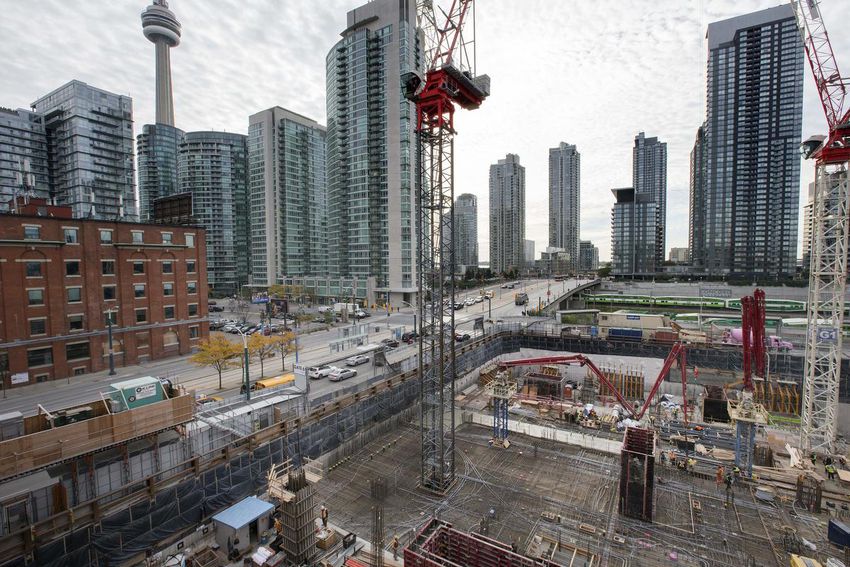Most Recent News
Digging Deep: a Look at the Well and the Massive Hole at Spadina and Front
October 20, 2018 | In The News
You wouldn’t want to fall down this Well.
There’s a wide and enormously deep, abyss-like hole — 20 metres down — at the corner of Spadina Ave. and Front St. where a massive construction project is going on.

A look at The Well, currently a construction site at the corner Spadina Ave. and Front St. W. that’s wrapping up the excavation phase, on Oct. 19. (ANDREW FRANCIS WALLACE / TORONTO STAR)
When it’s completed, the mixed-use development will have as many as 20,000 people living, working and shopping on the property on any given day, say those close to the project.
The development is called The Well, part play on words from its marketing slogan — eat, shop, live, work, and play well — and part reference to Wellington St. W., at the north side of the development.
The development promises 1.1 million square feet of office space, and 500,000 square feet of retail and food services.
The Well’s website bills it as the “most ambitious mixed-used endeavour in Canada.”
In terms of the size of the excavation site, Dan Nicholson, a senior city of Toronto planner, said he can’t confirm how The Well ranks compared to other large digs from Toronto’s past — the city doesn’t officially track that metric — but he did say it isn’t common to see a hole that large at a city construction site.

On any given day, hundreds of workers are at the site, which is 20 metres deep. (ANDREW FRANCIS WALLACE)
The gaping hole at the 7.8-acre site is a result of the fact that the parking levels and loading areas for the towers are being constructed at the same time — rather than in stages, as commonly done in most other developments.
“One of the things we believe makes this project work from a design aspect, is the fact we’re putting all the parking and all the loading below grade. In order to make that efficient and work for the entire project, it’s our belief it all has to be done at the same time,” says Andrew Duncan, senior vice-president, development for RioCan, the developer.

The development promises 1.1 million square feet of office space, and 500,000 square feet of retail and food services. (ANDREW FRANCIS WALLACE)
Seven buildings ranging in height from 13 storeys to 45 storeys are slated for the former Globe and Mail site bounded by Spadina Ave. to the east, Draper St. to the west, Front St. to the south, and Wellington; one tower with retail and office uses and the remaining six, residential — three with rental units and three with condos for a total of 1,700 residential units.
Total costs for the project are estimated at easily $1 billion.
Work began there last October and the retail/commercial component is due for completion around 2021. The residential buildings will be completed in phases after that.
Approvals from the city for the project are proceeding in stages, but the Official Plan amendment was approved in July 2015.

Crews at the 7.8-acre site are constructing the parking levels and loading areas for the towers at the same time ? rather than in stages, as commonly done in most other developments. (ANDREW FRANCIS WALLACE)
So what goes into running a massive, complex construction site like this?
On any given day there are supervisors and hundreds of construction workers on the site doing form work for concrete, and excavation. Later, when tradespeople join the site to do electrical and mechanical work, even more people will be in the hole.
There are currently five cranes on site, but that number will climb to around 12 in later stages of construction, Duncan says.

The site fills with a lot of dust and dirt and water is used to keep it down (ANDREW FRANCIS WALLACE)
There are temporary steps and a ramp that workers use to get in and out of the site. The ramp is also used to move some machinery and materials.
And as with any large construction site, a lot of dust and dirt gets stirred up during the digging. Water is used to keep the dust down, although that isn’t expected to be a concern much longer given excavation is due to wrap up in the next month or so.

Five cranes are being used. That number is expected to be 12 at later development stages. (ANDREW FRANCIS WALLACE)
Developers Diamond Corp, RioCan, Allied Properties, Tridel and Woodbourne Canada Management along with six architectural firms comprising the design partners are behind the development.
When the development is complete there won’t be space for cars except the underground lots. It will be a pedestrian-only space, with a busy network of connecting streets and a 450-metre-long and 18-metre-wide tree-lined promenade in the centre.
Other features will include parking spaces for 2,190 bicycles and a not-for-profit daycare centre for 57 children.

The Well’s website bills it as the “most ambitious mixed-used endeavour in Canada.” (ANDREW FRANCIS WALLACE)
“It’s going to be a fully integrated, mixed-use project. We’re excited about it,” Duncan says.
He added that although there are no plans for affordable residential units on the property, money from the development is being set aside for affordable units elsewhere in the city.
Source: The Toronto Star

